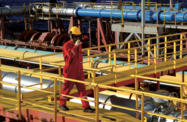Increased investment in Saudi Arabia’s mining sector looks set to lift its GDP contribution significantly in the coming years, as part of an accelerating push to diversify the economy under the Vision 2030 development plan.

On April 24 the governor of Makkah, Prince Khalid Al Faisal Al Saud, formally opened a new gold mine and processing plant – the Ad Duwayhi mine, owned and operated by the Saudi Arabian Mining Company (Ma’aden) – with a production capacity of 180,000 oz per year, making it the country’s largest to date.
Commercial production began last April, and the mine was set to reach 100% capacity by year’s end, according to a company statement at the time. While data on its current output has yet to be released, Ma’aden’s profits hit SR275.6m ($73.5m) in the first quarter of this year, up from SR194.3m ($51.8m) in the same period last year, according to a statement issued on May 7. An end-2015 company assessment estimated the mine’s total gold reserves at 1.9m oz.
Ma’aden said stronger sales, higher prices for gold and aluminium, and a tightening of operating costs drove first quarter earnings up 19.68% year-on-year (y-o-y) to SR2.7bn ($719.8m).
Total investment in Ad Duwayhi, which reached more than SR1.5bn ($400m), included a 450-km pipeline to remove processed wastewater from downstream operations and a 117-km road to link the site with the Riyadh-Taif highway.
Tapping richer veins
Ad Duwayhi is one of six gold mines operated by Ma’aden, and its opening should create opportunities for a range of firms in the gold extraction industry.
Detailed surveys record 600 gold-bearing sites so far, most of them in the country’s west, only 29 of which have seen initial exploratory drilling.
Some estimates put the value of Saudi Arabia’s gold reserves at $240bn, which alongside extensive reserves of bauxite, copper, uranium and phosphate, bring the total worth of its mineral reserves to as much as $1.3trn.
The sector’s potential could hold increased appeal for investors as the government moves to open new avenues for foreign investment – such as by easing ownership regulations on the stock exchange.
On May 20, during US president Donald Trump’s visit to Saudi Arabia, two memoranda of understanding were signed between Ma’aden and its two US-based partner companies, Alcoa and Mosaic.
The first will assess the feasibility of expanding capacity at its aluminium smelting complex in Ras Al Khair Industrial City by 600,000 tonnes per year, which the firm says could create 3000 jobs. The second will seek new areas of collaboration in the Kingdom’s phosphate industry.
Other international partnerships have already moved ahead. For example, Canadian-owned Barrick Gold invested $220m in a joint-venture copper mine with Ma’aden, which began commercial production in July 2016.
Aramco IPO set to boost mining sector
In early May Crown Prince Mohammed bin Salman Al Saud told local media that the Public Investment Fund will put some of the proceeds of Saudi Aramco’s initial public offering (IPO) towards further development of the mining industry.
“The fund will have a very large cash flow from Aramco, and at least 50% and up to 70% of this cash will be used in new sectors inside Saudi Arabia,” he said, singling out mining as a key target for investment.
While the Aramco IPO, scheduled to take place in 2018, will offer just 5% of the company’s shares to the public, the firm is thought to be valued at up to $2trn, implying significant cash flow for the Public Investment Fund.
The Kingdom is finalising a mining strategy to nearly quadruple the sector’s GDP contribution by 2030, from SR64bn ($17bn) to SR240bn ($64bn), according to Khalid Al Falih, minister of energy, industry and mineral resources, and chairman of Aramco.
Increased investment in mining aligns with the objectives of Vision 2030, the state’s blueprint for social and economic development issued last year.
As part of Vision 2030’s first phase, the National Transformation Programme aims to expand the sector to SR97bn ($25.9bn) by 2020, while raising sector employment from 65,000 to 90,000 jobs. The intermediate target would imply either maintaining or exceeding the sector’s annual growth of 9.2% over the past decade.
If realised, this would open many doors in the years to come, not only for mining companies and investors, but also for service providers and other downstream industries.


